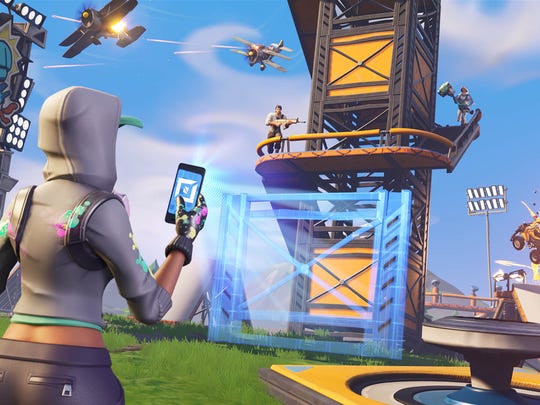There’s a cloud hovering over the future of video games. Not a cloud of impending doom, but more of uncertainty.
At the same time as Microsoft and Sony are prepping new video game consoles to go on sale in 2020, games delivered and stored online – in the cloud – are becoming all the rage.
Could the rise of cloud gaming mean that the next video game console system you buy may be the last?
Not necessarily. Even though we reliably stream music, TV and movies, for many reasons it will likely make sense to have a console, which is basically a powerful computer dedicated solely to games and entertainment, in your home.
Ten years from now, you may be still setting aside money for the latest PlayStation, Xbox or Nintendo system. “It’s likely that consoles will still be around, with more of a niche presence (like gaming PCs) for the hard core who wants the fastest and most graphically pure experience,” said Michael Pachter, analyst for Wedbush Securities.
However, he sees each generation of video game consoles likely selling fewer units, with each likely only one-half to three-fourths as large as the previous generation. At the same time, the global addressable market for games will increase tenfold and game sales will double by 2030, Pachter estimates.
Games streamed from the cloud, as opposed to those sold on a physical disc or downloaded to a console, will see gains in acceptance. “Late adopters are far more likely to adopt streaming earlier in the cycle and to forego the purchase of a console altogether,” Pachter said.
Privacy: Your data has been sold to websites like MyLife and WhitePages. Here’s how to remove it
Smart home guide: What you need to know to get plugged in to the connected life
In fact, the console game system as we know it “is already dead,” said Alexis Macklin, research manager at market intelligence firm Greenlight Insights. Macklin joined Pachter and several other tech analysts in offering email responses to USA TODAY about the future of video games.
“Console gaming is in transition to on-demand gaming services, and this transition has already begun,” she said. “Gaming is going digital and this will continue to change how Microsoft, Sony and Nintendo manufacture consoles – it already has.”
Microsoft has already brought to market an Xbox One S console without a disc drive, available at a lower price to cater to online-only players. Its new high-powered Xbox Series X, due out ahead of the 2020 holiday season, includes a disc drive, but it may be accompanied by a lower-priced next-generation console that does not have one, according to a report from video game news site Kotaku.
Xbox One S, left, and the Xbox One S All-Digital Edition. (Photo: Microsoft)
Microsoft is also testing its Project xCloud game streaming service, which could be played on any Microsoft console and other devices.
The PlayStation 5, also scheduled to be released prior to the 2020 holiday season, will use physical discs and plays 4K Blu-ray Discs.
The new consoles from Microsoft and Sony “may very well be the last consoles in the traditional sense,” Macklin said. “The next wave of consoles may be closer to a streaming media device than a traditional console box, with the focus more on accessories.”
Digital dominates video games
Until a few years ago, most consumers paid $40 to $60 for games on discs or cartridges and played those games, then went to a store and bought a new one. In 2013, spending on physical console and PC games accounted for $6.3 billion, far surpassing the $4.7 billion spent on downloaded digital games and in-game microtransactions on consoles and PCs, according to PricewaterhouseCoopers.
But by 2016, the marketplace had flipped with digital spending on console and PC games amounting to about $6.8 billion, compared to $5.7 billion for physical game revenue, according to PwC.
The move to digital is expected to accelerate and projected to surpass $11 billion in 2022, compared to $3.8 billion on physical spending, PwC estimates. (Consumer spending on digital games surpassed physical game spending before that, too, if you factored in the spending on app games bought for smartphones and mobile devices, and games played in web browsers, which collectively accounted for $3.4 billion in 2013 and $10.6 billion in 2018.)
During this time of transition, game developers will be creating new games that could drive changes, too. For instance, the free-to-play game “Fortnite,” which Epic Games released in 2017, generated $2.4 billion in revenue in 2018, research firm SuperData estimated. Since the game is free, all that revenue came from players buying content within the game, which can be played across the various consoles, computers and mobile devices.
(Photo: Epic Games)
There already are ways for gamers to experiment with cloud gaming. Microsoft’s Xbox Game Pass and Sony PlayStation Now are subscription services that, for a monthly fee, let you choose from hundreds of games stored in the cloud. Game publishers Electronic Arts and Ubisoft also have their own subscription services. Nintendo uses the cloud to offer classic NES games on the Nintendo Switch and, with some newer games, to save your progress and play with other players, too.
A ‘Netflix’ of gaming?
This move away from physical to digital is in part, generational, as younger consumers are less attached to ownership, says P.J. McNealy of consulting firm Digital World Research. “They get their music through Spotify or Apple Music subscriptions, and their video through Netflix or Hulu subscriptions,” he said. “Games are next on this horizon, and the days of buying a $60 game are likely ending for a segment of the population, replaced by a subscription to a service such as Xbox Game Pass.”
But, because many games remain “siloed with a specific publisher,” McNealy said, there is currently no “Netflix of Gaming.”
'Red Dead Redemption 2' is one of many games available on the Google Stadia cloud gaming service. (Photo: Rockstar Games)
Google is attempting to create a semblance of one. For its Stadia game streaming service, which launched last month, Google has deals with nearly 30 publishers including Bethesda, Electronic Arts, Rockstar Games and Ubisoft. To get started in Stadia, you buy a $129 Stadia Premiere Edition starter package (available in the Google Store) for a Chromecast Ultra streaming device to connect to your TV, controller and a three-month subscription (subsequent months are $9.99).
However, Stadia hasn’t gotten off to a smooth start with some players complaining about “input lag and poor resolution,” Macklin said.
Milliseconds between taps on a controller and a response on the screen are crucial, because a lag in response disrupts the game. But consumers understand streaming and once those issues are solved, “streaming will be more accepted,” she said.
Sony is partnering with Microsoft on cloud gaming technology. And Electronic Arts, Amazon and Apple are also working on game streaming services.
Cloud gaming will evolve
Despite additional competition, Microsoft and Sony will “thrive in a streaming world, as each has a large installed base of paying multiplayer customers (on Xbox Live and PlayStation Network) to support expansion into streaming,” Pachter said. “At the end of the day, streaming is an expensive service to provide, but Microsoft and Sony have a lot to lose if they cede this segment to Google, Apple or Amazon, so I expect each to offer a competitive platform and to thrive.”
With all the resources being focused on cloud games, “a decade from now console gaming will likely be known as television gaming or even large-screen gaming,” said Jesse Divnich, vice president of research and strategy at Interpret, a global consumer insights agency.
“Cloud streaming will almost undoubtedly reach a point where it can provide a seamless experience across any type of game,” Divnich said. “There will always be traditionalists that prefer a physical device in their house, but most consumers will adopt cloud streaming as a means of accessing games.”
For many consumers, connectivity itself will be the biggest barrier – and could prolong devotion to consoles. “Currently, most larger ISPs do not provide unlimited data plans, most have monthly data caps, making cloud gaming cost prohibitive,” said Wanda Meloni, CEO and principal analyst for M2 Insights, a research and consulting firm. “Aside from the cost, many rural areas do not yet even have access to broadband.”
That’s why “it won’t be a swift or direct path from console or PC, to the cloud,” she said. “It will require several interim hybrid solutions as these technologies themselves evolve.”
Since most game consoles have a lifespan of 6.5 years, the new consoles released next year will remain in the marketplace “until at least the 2026-2027 time frame,” Meloni said.
5G networks, which cellular providers are beginning to roll out, will eventually help drive cloud gaming, too. Some 5G signals can deliver data at 60 times the speed of current networks. But the availability and robustness of the signals depend on where you live and what provider is there.
“Even with the rollout of 5G, consistent connectivity across users cannot be guaranteed,” Macklin said. “Therefore gamers will look for devices that can house localized content and support a consistent resolution.”
Gaming’s multi-faceted future
Phil Spencer, Microsoft’s head of Xbox, declined to declare whether Project Scarlett would have a successor coming in seven years or so. “I’m also certain I won’t be able to predict what developers will achieve over the next decade with new consoles, which will introduce a tremendous amount of creative flexibility for creators, and a lot of day-to-day convenience for players looking for an immersive living room experience.”
A decade from now, a maturing cloud gaming environment will have made games available to more players, he said in a statement sent to USA TODAY. “And with more players and independent creators joining, from more countries and backgrounds, we’ll be seeing ideas and perspectives that we haven’t had a chance to see in games to date,” Spencer said.
For Sony, the PlayStation console “remains the centerpiece of the experience, but we have evolved what PlayStation means beyond hardware with our network, our services, our global community, and of course our exclusive content,” Jim Ryan, president and CEO of Sony Interactive Entertainment, said in a statement to USA TODAY.
“Like all consumer devices, consoles will continue to evolve and may mean something very different someday,” Ryan said, “but we aren’t there yet.”
By 2030, “most people on the planet will have grown up with console gaming,” he said. “It will be really exciting to see where new creative voices, and a larger global audience, take the medium.”
Follow USA TODAY reporter Mike Snider on Twitter: @MikeSnider.
Video game accessories: Fine tune the feel, sound and seat of your game
5G service: Super-fast cellular connections are here, but do you really need to get a 5G phone now?
Source: Read Full Article



